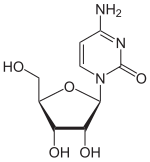
| |

| |
| Names | |
|---|---|
| IUPAC name
Cytidine
| |
| Systematic IUPAC name
4-Amino-1-[(2R,3R,4S,5R)-3,4-dihydroxy-5-(hydroxymethyl)oxolan-2-yl]pyrimidin-2(1H)-one | |
| Other names
4-Amino-1-β-D-ribofuranosyl-2(1H)-pyrimidinone[1]
4-Amino-1-[3,4-dihydroxy-5-(hydroxymethyl)tetrahydrofuran-2-yl]pyrimidin-2-one | |
| Identifiers | |
3D model (JSmol)
|
|
| ChEBI | |
| ChEMBL | |
| ChemSpider | |
| ECHA InfoCard | 100.000.555 |
| KEGG | |
| MeSH | Cytidine |
PubChem CID
|
|
| UNII | |
CompTox Dashboard (EPA)
|
|
| |
| |
| Properties | |
| C9H13N3O5 | |
| Molar mass | 243.217 |
| Appearance | white, crystalline powder[2] |
| Melting point | 230 °C (decomposes)[1] |
| -123.7·10−6 cm3/mol | |
Except where otherwise noted, data are given for materials in their standard state (at 25 °C [77 °F], 100 kPa).
| |
Cytidine (symbol C or Cyd) is a nucleoside molecule that is formed when cytosine is attached to a ribose ring (also known as a ribofuranose) via a β-N1-glycosidic bond. Cytidine is a component of RNA. It is a white water-soluble solid[2] that is only slightly soluble in ethanol.[1]
Dietary sources[edit]
Dietary sources of cytidine include foods with high RNA (ribonucleic acid) content,[3] such as organ meats, brewer's yeast, as well as pyrimidine-rich foods such as beer. During digestion, RNA-rich foods are broken-down into ribosyl pyrimidines (cytidine and uridine), which are absorbed intact.[3] In humans, dietary cytidine is converted into uridine,[4] which is probably the compound behind cytidine's metabolic effects.
Cytidine analogues[edit]
A variety of cytidine analogues are known, some with potentially useful pharmacology. For example, KP-1461 is an anti-HIV agent that works as a viral mutagen,[5] and zebularine exists in E. coli and is being examined for chemotherapy. Low doses of azacitidine and its analog decitabine have shown results against cancer through epigenetic demethylation.[6]
Biological actions[edit]
In addition to its role as a pyrimidine component of RNA, cytidine has been found to control neuronal-glial glutamate cycling, with supplementation decreasing midfrontal/cerebral glutamate/glutamine levels.[7] As such, cytidine has generated interest as a potential glutamatergic antidepressant drug.[7]
Related compounds[edit]
- Deoxycytidine is cytosine attached to a deoxyribose.
Properties[edit]
References[edit]
- ^ a b c William M. Haynes (2016). CRC Handbook of Chemistry and Physics (97th ed.). Boca Raton: CRC Press. pp. 3–140. ISBN 978-1-4987-5429-3.
- ^ a b Robert A. Lewis, Michael D. Larrañaga, Richard J. Lewis Sr. (2016). Hawley's Condensed Chemical Dictionary (16th ed.). Hoboken, New Jersey: John Wiley & Sons, Inc. p. 688. ISBN 978-1-118-13515-0.
{{cite book}}: CS1 maint: multiple names: authors list (link) - ^ a b Jonas DA; Elmadfa I; Engel KH; et al. (2001). "Safety considerations of DNA in food". Ann Nutr Metab. 45 (6): 235–54. doi:10.1159/000046734. PMID 11786646.
- ^ Wurtman RJ, Regan M, Ulus I, Yu L (Oct 2000). "Effect of oral CDP-choline on plasma choline and uridine levels in humans". Biochem. Pharmacol. 60 (7): 989–92. doi:10.1016/S0006-2952(00)00436-6. PMID 10974208. S2CID 18687483.
- ^ John S. James. "New Kind of Antiretroviral, KP-1461". AIDS Treatment News. Archived from the original on 2019-03-30. Retrieved 2012-03-23.
- ^ "Scientists reprogram cancer cells with low doses of epigenetic drugs". Medical XPress. March 22, 2012.
- ^ a b Machado-Vieira, Rodrigo; Salvadore, Giacomo; DiazGranados, Nancy; Ibrahim, Lobna; Latov, David; Wheeler-Castillo, Cristina; Baumann, Jacqueline; Henter, Ioline D.; Zarate, Carlos A. (2010). "New Therapeutic Targets for Mood Disorders". The Scientific World Journal. 10: 713–726. doi:10.1100/tsw.2010.65. ISSN 1537-744X. PMC 3035047. PMID 20419280.
Well, that’s interesting to know that Psilotum nudum are known as whisk ferns. Psilotum nudum is the commoner species of the two. While the P. flaccidum is a rare species and is found in the tropical islands. Both the species are usually epiphytic in habit and grow upon tree ferns. These species may also be terrestrial and grow in humus or in the crevices of the rocks.
View the detailed Guide of Psilotum nudum: Detailed Study Of Psilotum Nudum (Whisk Fern), Classification, Anatomy, Reproduction